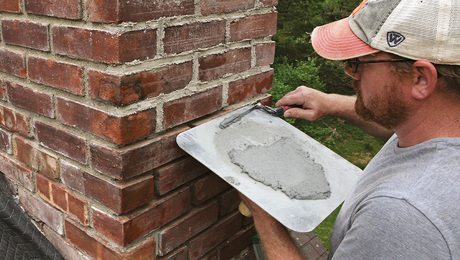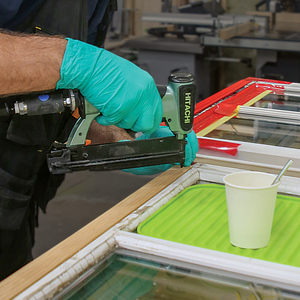Need help with 2 issues. Installing cermic tiles in a bath remodel and will be putting down 1/2 denshield backerboard over subfloor. Does the backer b. have to be set in thin set prior to being screwed to ply. subfloor? It scares me to think down the road if I ever wanted to change the tiles, the backer b. would be impossible to remove to add new, etc. Also, when using leveling compound, does it go down over the subfloor or backer B. or does it matter?
Thanks



















Replies
It's my understanding that backer board does in fact have to be set in thinset before being screwed down. As far as the self leveling I'll tell you what I did in my own batchroom.
We had to gut the bathroom due to some water problem from the last owners so we ripped the floor up, down to the joists. New plywood decking, then 1/2" wonderboard over thinset. Then thinset and tape the joints. Then I laid down electric radiant heating wires, and covered that with self leveling compound. Finally, tile.
Not that you won't get great help here in Breaktime, but I found that John Bridges site, http://www.tileyourworld.com , was super helpful with my bath project. Quick responses from guys who do nothing but tile.
Like I said this is an awesome forum, but for some absolutely tile specific info I'd suggest John's site.
Good luck,
kh
Thanks Fourquarter for the great link. I agree, this forum is great, but there can be others more specific to a certain trade.
HK
I always thin-set my backer board to the subfloor, then screw it.
I would pour the self-leveling goop over the subfloor first, prior to the backer board.
Mike
Be careful with the self leveling stuff because it will find every tiny hole and gap and then pour through.
Got that right! That stuff is like water and I had an experience once that I wouldn't want to have happen again. I'll just sum it up by saying that below the bathroom where I used the self leveling compound (SLC) was a finished basement with a drop ceiling. I'll let you guess the rest (picture gray rain). From now on I use duct tape on any area that doesn't look it would hold the SLC.
What do the instructions for Denshield say re thinset over the subfloor? What do the instructions for the self-leveling compound say re installing over subfloor vs. Denshield. I would read the manufacturer's instructions for all of the products you are going to use.
If you are using self-leveling compound, why would you double your work and install backerboard as well? Unless you don't have anything better to do.
You don't need to install both.
We have almost eliminated using backer board on all but the smallest projects.
It is faster, and gives us an almost perfectly level substrate to lay our tile on. Just make sure to depth trowel it, and don't forget to tape or caulk all seams.
It is more expensive, but it is an easy upsell to the home owner when I explain the advantages of the system.
sully
Please explain what you mean by "depth trowel?" Thanks.Bill
Sully,I meant to add this to my previous post. Do you (always? ever?) use metal mesh in your self-leveling underlayment for stiffness/crack resistance?Bill
By depth troweling I mean that we use a "comealong", kind of like a gardeners rock rake, except we can adjust the depth somewhat to help move the material where it needs to be.
If you don't trowel it before it starts to set up, you will be left with high/low spots, and of course that defeats the "self leveling" portion of the equation. work fast and always have at least 3 people on site, if the floor is of any significant size. Oh yeah, always start your pour from the low spot and let it flow from there.
I always place screening down even if the mfgr. doesn't require it.
One thing that I have learned is to follow the mfgr's. instructions to a "t" because if there are cracking/separating/movement issues in the future, you will at least have some kind of a leg to stand on.
I actually had a job where the batch of compound was bad from the factory, and the company knew it. By having a good relationship with my rep, the company actually paid to have the floor demo'd and new tile set.
sully
Sully,Thanks for that. I used the self-leveling compound in my remodel of our master bathroom. The framers must have been half asleep when it was built and the floor was 1 inch out of level over 8 feet. I could live with that in the bedroom, but not in our jewel of a bathroom. The vanity toekick would have varied in height by half an inch. I laid cork in ours, but it seemed like an ideal tile substrate. Sure is solid, especially at the old low point with 1-1/8" of plywood and 1-1/4" of compound over that!Bill
Would you expand on "self leveling" compound. I've never heard of it. Thanks
Self leveling is a catch all term for a cement based compound that is mixed with water to a consistency of thick paint.
You simply mix and pour it over the sub floor and it finds it's own level.
Most of the mixes dry for light traffic in 2 hours and tiling in as little as 3-4.
Pretty cool stuff and easier than backerboard. I think cost comes out quite even with the backerboard after labor is figured in, because it sure goes down faster.
sully
Thanks sully,Pouring something that wet seems to go against the fundamentals (too wet grout, too wet concrete, etc)? Do you put a plastic grid in it? Do you think it turns out strong enough?
Heres a step by step instruction from the Journal of Light Construction,
Thanks Sbds!
it's amazingly strong and your knees will feel better for not having to screw down a bunch of backer board.
sully
Interesting approach to avoiding backerboard. In my case, I am using some leveler, than bridging the small stuff with the backerboard. Final thin set will level the rest. (Im hoping at least).
Thanks, I will still look into using just the leveler though.